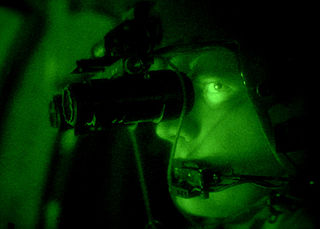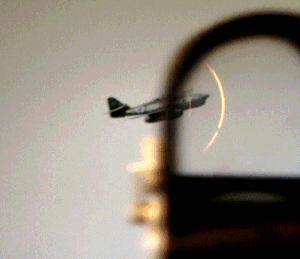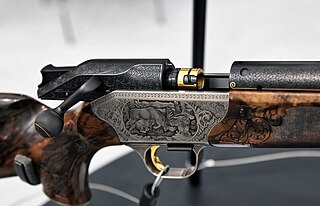
A monocular is a compact refracting telescope used to magnify images of distant objects, typically using an optical prism to ensure an erect image, instead of using relay lenses like most telescopic sights. The volume and weight of a monocular are typically less than half of a pair of binoculars with similar optical properties, making it more portable and also less expensive. This is because binoculars are essentially a pair of monoculars packed together — one for each eye. As a result, monoculars only produce two-dimensional images, while binoculars can use two parallaxed images to produce binocular vision, which allows stereopsis and depth perception.

A night-vision device (NVD), also known as a night optical/observation device (NOD), night-vision goggle (NVG), is an optoelectronic device that allows visualization of images in low levels of light, improving the user's night vision. The device enhances ambient visible light and converts near-infrared light into visible light which can be seen by the user; this is known as I2 (image intensification). By comparison, viewing of infrared thermal radiation is referred to as thermal imaging and operates in a different section of the infrared spectrum. A night vision device usually consists of an image intensifier tube, a protective housing, and may have some type of mounting system. Many NVDs also include a protective sacrificial lens, mounted over the front lens (ie. objective lens) on NVDs to protect the latter from damage by environmental hazards and some can incorporate telescopic lenses. The image produced by an NVD is typically monochrome green, as green was considered to be the easiest color to look at for prolonged periods in the dark. Night vision devices may be passive, relying solely on ambient light, or may be active, using an IR (infrared) illuminator to better visualize the environment.

A reticle, or reticule also known as a graticule, is a pattern of fine lines or markings built into the eyepiece of an optical device such as a telescopic sight, spotting scope, theodolite, optical microscope or the screen of an oscilloscope, to provide measurement references during visual inspections. Today, engraved lines or embedded fibers may be replaced by a digital image superimposed on a screen or eyepiece. Both terms may be used to describe any set of patterns used for aiding visual measurements and calibrations, but in modern use reticle is most commonly used for weapon sights, while graticule is more widely used for non-weapon measuring instruments such as oscilloscope display, astronomic telescopes, microscopes and slides, surveying instruments and other similar devices.

The Squad Advanced Marksman Rifle (SAM-R) is a semi-automatic designated marksman rifle developed and used by the United States Marine Corps. It gave users the capability to provide fire in support of a rifle squad, providing precision fire in support of an assault, and aid in observation and adjusting of supporting arms.

A sight is an aiming device used to assist in visually aligning ranged weapons, surveying instruments or optical illumination equipments with the intended target. Sights can be a simple set or system of physical markers that have to be aligned together with the target, or optical devices that allow the user to see an optically enhanced — often magnified — target image aligned in the same focus with an aiming point. There are also sights that actively project an illuminated point of aim onto the target itself so it can be observed by, such as laser sights and infrared illuminators on some night vision devices.

A rail integration system (RIS), rail accessory system (RAS), rail interface system, or simply rail system, is a generic term for a standardized system for attaching accessories to firearms. Rail systems are straight mounting brackets on the gun's receiver, handguard, or fore-end stock to allow sliding or variable-position attachments. An advantage with the multiple rail slots is the moveable positions to adjust for optimal placement of each item for each different user, along with the ability to switch different items at different placements due to varying eye reliefs on gun sights. Tactical usage and shooting sports have both benefited from the extra options provided.
Meopta - optika, s.r.o. is a Czech Republic based company that manufactures various products mainly in the field of optics. The company was once well-known for its still and movie cameras, although it no longer manufactures such products.
Bushnell Corporation is an American firm that specializes in sporting optics and outdoor products. It is based in Overland Park, Kansas and is a wholly-owned subsidiary of Vista Outdoor. Bushnell makes binoculars, telescopes, spotting scopes, riflescopes, red dot sights, GPS devices, laser rangefinders, game cameras, night-vision devices and other optical equipments.

The Salvadoran Army is the land branch and largest of the Armed Forces of El Salvador.
Tasco sells consumer telescopes. Tasco mainly imports telescopes for amateur astronomers but has expanded into other optical products, such as spotting scopes, microscopes, binoculars, telescopic sights, and other rifle accessories. Tasco sells via retail stores, catalogs, and online retailers. Tasco is based in Miramar, Florida. George Rosenfield founded the firm as the Tanross Supply Company in 1954. It started as a distributor of fishing tackle and hardware. The name was later shortened to Tasco as its offerings expanded to include binoculars and eyepieces.
Leupold & Stevens, Inc. is an American manufacturer of telescopic sights, red dot sights, binoculars, rangefinders, spotting scopes, and eyewear located in Beaverton, Oregon, United States. The company, started in 1907, is on its fifth generation of family ownership.
Noblex, formerly Docter Optics, is a German manufacturer of optics, including binoculars, rifle scopes, spotting scopes, red dot sights, flashlights and reading glasses. Its headquarters are in Eisfeld, Thuringia, Germany, where most of the products are developed and manufactured. Docter is part of the Analytik Jena Group.

A red dot sight is a common classification for a type of non-magnifying reflector sight for firearms, and other devices that require aiming, that gives the user a point of aim in the form of an illuminated red dot. A standard design uses a red light-emitting diode (LED) at the focus of collimating optics which generates a dot-style illuminated reticle that stays in alignment with the weapon the sight is attached to, regardless of eye position. They are considered to be fast-acquisition and easy-to-use gun sights for civilian target shooting, hunting, or in police and military applications. Aside from firearm applications, they are also used on cameras and telescopes. On cameras they are used to photograph flying aircraft, birds in flight, and other distant, quickly moving subjects. Telescopes have a narrow field of view and therefore are often equipped with a secondary "finder scope" such as a red dot sight.

A reflector sight or reflex sight is an optical sight that allows the user to look through a partially reflecting glass element and see an illuminated projection of an aiming point or some other image superimposed on the field of view. These sights work on the simple optical principle that anything at the focus of a lens or curved mirror will appear to be sitting in front of the viewer at infinity. Reflector sights employ some sort of "reflector" to allow the viewer to see the infinity image and the field of view at the same time, either by bouncing the image created by lens off a slanted glass plate, or by using a mostly clear curved glass reflector that images the reticle while the viewer looks through the reflector. Since the reticle is at infinity it stays in alignment with the device to which the sight is attached regardless of the viewer's eye position, removing most of the parallax and other sighting errors found in simple sighting devices.

Blaser Jagdwaffen GmbH is a German firearms manufacturer of high-end shotguns and rifles both for the hunting and tactical market. It was founded in 1957 by Horst Blaser, developing the drilling Blaser Diplomat. In September 2008, Blaser established a headquarters in San Antonio, Texas.

A holographic weapon sight or holographic diffraction sight is a non-magnifying gunsight that allows the user to look through a glass optical window and see a holographic reticle image superimposed at a distance on the field of view. The hologram of the reticle is built into the window and is illuminated by a laser diode.

Scope mounts are used to attach telescopic sights or other types of sights to firearms. The scope sight itself is usually made for only one of two main types of mounts, which can be classified as scopes for ring mounts or scopes for rail mounts. Words such as mounts and bases are used somewhat loosely, and can refer to several different parts which are either used together or in place of each other as ways to mount optical sights to firearms. When it comes to the interface of the firearm itself, the Picatinny rail is one of the most widespread standard for new firearms as of 2020. While most scopes are made for being mounted either with a ring mount or a rail mount, some sights have an integral mounting mechanism allowing them to be attached directly to the firearm, like for example an integrated Picatinny mount. In addition, there are many proprietary and brand-specific types of mounts that either can be used with Picatinny rails or as alternatives to Picatinny. Scope mounts may be offered by firearm and scope manufacturers, or on the aftermarket.

The Next Generation Squad Weapon (NGSW) program is a United States military program created in 2017 to replace the 5.56mm M4 carbine and M249 SAW light machine gun and the 7.62mm M240 machine gun, with a common system of 6.8mm cartridges; and to develop small arms fire-control systems for the new weapons.

A red dot magnifier is an optical telescope that can be paired with a non-magnifying optical sight on a weapon to create a telescopic sight. They work with the parallel collimated reticle image produced by certain non-magnifying sights so, contrary to the name, they can be used with sights other than red dot sights, like holographic weapon sights.

A prism sight or prismatic sight, sometimes also called prism scope or prismatic scope, is a type telescopic sight which uses a roof prism for its image-erecting system. The use of prisms makes it possible to construct a shorter and lighter sight, or with an offset between the eyepiece and objective axes.















